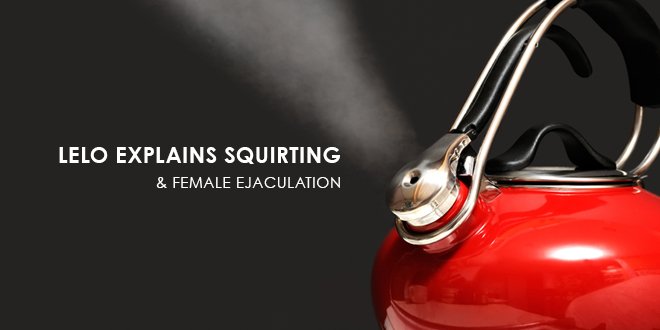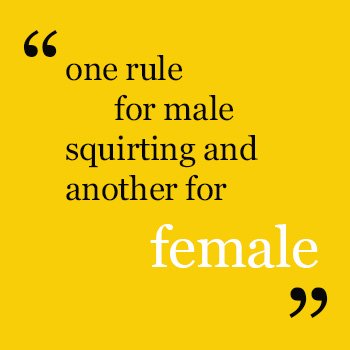Let’s be up front: this is an article about female ejaculation. An ejacularticle, if you will. As such, there is some graphic and explicit language ahead, and necessarily so, because the more openly we talk about it now, the less we’ll need to talk about it in the future. There is increasing interest around squirting at the moment, the discussion of it becoming broader even while the depiction of it becomes more heavily controlled.
But what is female ejaculation and why should it be a contentious issue?

Pornhub, the online porn empire with a rather excellent statistical team and a knack for viral infographics, released data last year showing that ‘squirting’ was the 7th most searched term for their site in 2014, and that more women are looking for it than men. Since so many people are searching for it, you might think more people would know exactly what it is, but that doesn’t seem to be the case. In fact, even in the introduction of this article, we conflated ‘squirting’ and ‘female ejaculation’ as though they were the same entities. They’re not: female ejaculation, squirting, gushing and G-spot orgasm are often all used interchangeably to refer to the same thing, but they’re all different, and they all have unique characteristics. And yet, they’re all closely related to each other.
Is Female Ejaculation Real?
“Much of the confusion around female ejaculation and squirting is because they are two separate phenomena that are often discussed indistinguishably,” says Dr. Ian Kerner, renowned sexual therapist and author of She Comes First. “While it’s not correct to refer to squirting as a G-spot orgasm, it may be a simple way to think about the experience. Some women squirt voluntarily, some women do so involuntarily. Some women report pleasure, others do not.”

Erotic author Ashleigh Lake agrees that there is confusion and complexity not only around the naming conventions of squirting, but the physiology too. “The Skene’s gland is anatomically near or part of the G-spot and is basically like the female version of the male prostate gland. Glands produce hormones, however during arousal they also produce fluid. In the female body this fluid can be suddenly released with vigorous or prolonged stimulation.”
‘Squirting’ is fast becoming the overarching name for all of the terms related to female ‘fluid emancipation’, as it’s euphemistically called in some older academic papers. The fact that there’s even debate about its existence – and further that there’s still debate about the existence of the G-spot too, is incredible. Most rationally minded and sexually active people will acknowledge the existence of both. So let’s just say it plainly: female ejaculation is real. But a question remains: why does female ejaculation exist? Does squirting serve a specific sexual function?
Why Do Women Squirt?
“The capacity [for women] to ejaculate is probably an evolutionary by-product of the selection of this trait in men,” says Dr. Kerner. “Male and female genitals are homologous (male genitals grow out, female grow in) and are undifferentiated for the first few months of pregnancy. Similar to the selection of nipples in women as a crucial function, and the male nipple being a by-product. This is not to disparage female sexual function, just to point out the difference.”
But this only raises more questions. If the female ejaculation is vestigial, why hasn’t evolution selected it out by now?
That’s probably because of the functions involved. It’s not like the Skene’s gland, popularly referred to as ‘the female prostate’ due to its similarity to the male prostate in form and function, is switched off when it’s not involved in ejaculation. Just like the male prostate, the Skene’s gland is constantly working, assisting in sexual function in any number of ways, from producing lubrication to keeping you clean and healthy. It’s a vital component for sexual health, and so is its function. By extension, if the physiology that produces female ejaculation is necessary, so must be female ejaculation itself. It may be an evolutionary by-product, but it’s certainly not vestigial.
Why Is Squirting Porn Banned?

So if female ejaculation is literally the equal of – and equivalent to – male ejaculation, why is there such a difference in the way they’re perceived? For example, among many other sex acts and for reasons that were never identified, December 2014 saw the British government outlaw the depictions of female ejaculation in pornography. No such ban was put in place for male ejaculation. The implication is clear: men’s orgasms = great, women’s orgasms = obscene. And while that law was exclusive to the UK, it only takes common sense to see that there is a major disparity in the way we view male and female ejaculation around the world. Why the difference? Why one rule for male squirting and another for female?
“I think historically there’s been debate about female pleasure in general,” says respected sex toy reviewer and sex writer Epiphora. “Male pleasure is seen as standard, common, and important. Female pleasure is seen as amorphous, mysterious, and secondary.”
The UK’s leading sex toy reviewer and sex writer Cara Sutra agrees. “Traditionally, ejaculation was viewed entirely as being men’s domain. I don’t know of any historical references to female ejaculation.”
The History Of Squirting

In fact, some historical references do exist, though you have to look really hard to find them. They date back 2000 years. Female ejaculation was apparently very well known in ancient Asia and mentioned in several Chinese Taoist texts, starting in the 4th century. The ancient Chinese concept of female ejaculation as independent of reproduction was supported by ancient Indian writings. First mentioned in a 7th century poem, female ejaculation and the G-spot are described in detail in most works of the Kāmaśāstra. In ancient Western writings it’s mentioned even earlier, around 300 B.C. by Aristotle and in the 2nd century by Galen. But then, mentions of it go almost completely silent until Dr. Graffenburg (who essentially put the ‘G’ in ‘G-spot’) in 1952. It’s like we discovered it, then forgot about it for 1500 years, and we’re only rediscovering it now.
“Attempting to control the way female ejaculation is viewed in porn (off-camera, implied etc) or banning it entirely just seems to be another way of relegating women to the bottom of the gender pile,” continues Cara Sutra. “If women are allowed (the fact that permission is necessary is an insult in itself) to ejaculate visually, audibly, pleasurably in porn then this challenges ejaculation as being just a ‘man thing’”.
In fact, Ashleigh Lake goes a step further, with the observation that in pornography “female ejaculation still tends to be portrayed as the result of a man’s efforts and sexual prowess…. unless the gender roles are equalized in a lesbian scene.”
In porn, then, it seems that women are very rarely allowed to “own” their own ejaculation. It’s either bound up in femdom fetishism, or it’s the result of a man’s prowess, or it’s so exaggerated that it bears little resemblance to the reality of the experience, or it’s illegal. (Though Ashleigh Lake does point out the good work being done by the producer Madison, otherwise known as Sam No.)
Those same standards that we criticize – those about the unrealistic standards of sex depicted in porn that allegedly corrupt men at a young age – are now true of squirting, and potentially equally damaging. Squirting in most porn is unrealistic, and could lead to unrealistic expectations amongst women. Worse still though is banning it, which could lead to a woman’s shame at her own climax.
Conclusion
The truth about female ejaculation, squirting, gushing and G-spot orgasm is, unfortunately, that it’s not something that comes easy, so to speak. It takes patience, a little education, some hard work, and – maybe – the anatomy too. In our recent survey of around 1000 participants, just 12% of respondents said they squirt regularly, but of those who don’t a massive 72% said they wanted to try.
[related_article id=”11024″ float=”right” size=”full” target=”_blank”]

